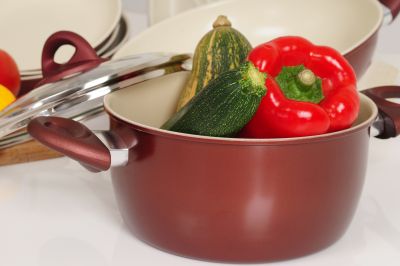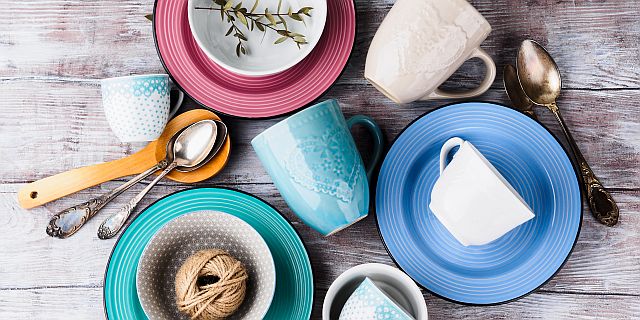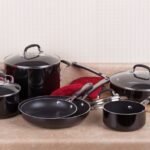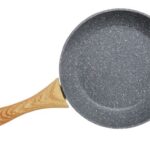Leaching chemicals into food is one of the biggest problems with nonstick cookware. Some components used in the production of cookware can contaminate food during cooking. Ingesting a metal not only affects the taste of your meal but it also comes with potential health risks. The accumulation of metals in the body can lead to various health problems.
Although ceramic cookware is often claimed to be a healthy alternative to Teflon, some ceramic utensils contain heavy metals that can harm your health. You may want to learn about potential health risks before purchasing this cookware type for your kitchen.
What is Ceramic Cookware made of?
There are two basic types of ceramic cookware:
• 100%ceramic cookware and
• Ceramic-coated cookware
Let’s dive deeper into the safety concerns of both types of ceramic cookware.
1. Ceramic-Coated Cookware

Ceramic-coated cookware has a metal body, while the cooking surface is made of a ceramic-based non-stick coating. The base is usually made of aluminum to ensure good heat distribution in the pan.
Manufacturers of ceramic-coated cookware claim that the nonstick coating is free of toxic chemicals because the ceramic layers are designed to prevent metal from getting into the food.
Related cookware set: SENSARTE 3-Piece Nonstick Ceramic Cookware Set (sponsored link to Amazon)
Is Ceramic-Coated Cookware Safe for Food Preparation?
Unlike metal, the materials used in ceramic coating are soft and prone to chipping with continuous use. The ceramic coating deteriorates over time. In most cases, this cookware can be used for about 3 to 5 years under normal conditions before showing signs of deterioration.
The older models consist of a thin ceramic layer that wears easily with use. Metal utensils and abrasives can scratch the cooking surface. The metal can then separate from the bottom and penetrate the food being cooked
Nowadays, manufacturers use multiple ceramic layers to make their cookware more durable. Over the last decade, there have been several improvements in the production process to ensure better quality ceramic coating.
How to Stay on the Safe Side
Before and after purchasing ceramic-coated cookware, be sure to follow these basic guidelines:
- Never buy ridiculously cheap cookware. Such cookware items are likely to have a coating of questionable quality that will deteriorate more quickly than the coating on comparable, more expensive items.
- Make sure you buy cookware from a reputable company.
- Ask the questions and read the label carefully.
- Follow instructions for proper use and maintenance.
- Discard items with chipped interior surfaces.
2. 100% Ceramic Cookware
This ceramic cookware is made by pouring a mixture of clay and water into pre-made molds. These molds are then fired in a kiln for an extended period to create a hardened surface.
The problem with older types of pure ceramic cookware, especially cheap brands, was that they were prone to cracking and breaking. This problem has recently been solved through the use of new production methods
Some brands, including XtremaCeramcor and Emile Henry cookware, are crack-resistant and highly durable. These pure ceramic cookware brands are also considered non-reactive and completely free of harmful substances.
Pure ceramic cookware is one of the safest ways to cook and serve food.
Concerns about 100% Ceramic Cookware Glaze
The glaze gives ceramic pans a smooth, shiny surface and prevents moisture from penetrating the surface. Ingredients used in glaze production include lead and cadmium, which are toxic to human health. These heavy metals can leach into foods cooked, stored, or served in glazed utensils. At higher temperatures, the leaching is more intense.
Lead can build up in the human body and cause health problems over time. According to some studies, regular use of certain types of glazed ceramic cookware can cause lead poisoning and serious health problems in children.

About Regulations
The following is a summary of the U.S. Food and Drug Administration’s regulations regarding lead levels in cookware and tableware
- Dishes that exceed FDA limits should not be sold in the United States.
- California’s Proposition 65 requires all businesses to warn buyers about possible lead exposure.
- If dishes have been tested and are known to leach lead more than Proposition 65 requirements, a warning must be posted to inform the public.
- This warning consists of a yellow triangle and a message placed next to or on the affected cookware when it is displayed for sale.
- Only dishes whose lead content is below the standards set by Proposition 65 are considered safe.
Overall, manufacturers in the US must follow FDA guidelines. Therefore, ceramic cookware made in the USA is considered safe for human use. However, manufacturers in other countries may not be bound by the same rules. Imported ceramic cookware may contain lead in amounts above FDA-approved levels.
How to Reduce the Risk of Lead Exposure when Using Ceramic Cookware
- Always check safety certifications before purchasing glazed ceramic cookware.
- Follow the manufacturer’s instructions for using and caring for this cookware.
- Only buy glazed clay cookware from a reputable manufacturer. Typically, these manufacturers clearly state that the product is free of potentially harmful substances.
- Always avoid buying cheap ceramic products. Buy ceramic cookware that is proven to be safe, even if it is more expensive.
- Always ask questions before purchasing. Ask the seller whether the product meets the standards outlined in Proposition 65.
- Keep in mind that imported ceramic cookware may not be entirely safe for cooking, storing, or serving food. Therefore, avoid using them for those purposes at all costs.
- Be careful when purchasing items with colorful glazed interior surfaces. Bright colors on the outside usually do not pose a problem, but you should avoid putting such items in the dishwasher.
- Never use handmade, homemade, and antique dishes for food preparation, as these dishes could have been made before the permissible limit for lead content in cookware was established.



